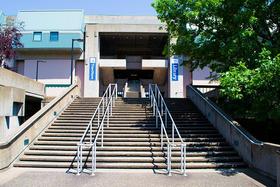- Ogden鈥揥eber Technical College is a public technical college in Ogden, Utah. It is one of the largest of the eight technical colleges within the Utah System of Higher Education. The college offers open-entry, open-exit, competency-based education targeted at technical skills and job placement.
School Highlights
Ogden-Weber Technical College serves 4,719 students (13% of students are full-time).
The college's student-teacher ratio of 19:1 is higher than the state community college average of 16:1.
Minority enrollment is 39% of the student body (majority Hispanic), which is more than the state average of 29%.
Quick Facts (2025-26)
- Enrollment: 4,719 students
- Student-teacher ratio: 19:1
- Minority enrollment: 39%
- Source: Integrated Postsecondary Education Data System (IPEDS)
School Overview
The teacher population of 254 teachers has stayed relatively flat over five years.
Ogden-Weber Technical College
(UT) Community College Avg.
Carnegie Classification
Not applicable, not in Carnegie universe (not accredited or nondegree-granting)
Not applicable, not in Carnegie universe (not accredited or nondegree-granting)
Institution Level
Less than 2 yrs
Four or more years
Institution Control
Public
Public
Colors
Black, Red
Total Faculty
254 staff
215 staff
Number of Programs Offered
29
23
Student Body
The student population of Ogden-Weber Technical College has grown by 89% over five years.
The student-teacher ratio of 19:1 has increased from 10:1 over five years.
The Ogden-Weber Technical College diversity score of 0.52 is more than the state average of 0.47. The school's diversity has grown by 10% over five years.
Total Enrollment
4,719 students
4,285 students
Student-Teacher Ratio
19:1
16:1
# Full-Time Students
593 students
891 students
# Part-Time Students
4,126 students
3,394 students
# Enrollment Undergraduate
471 students
367 students
# Full-Time Undergraduate Students
593 students
891 students
# Full-Time Graduate Students
n/a
133 students
# Part-Time Undergraduate Students
n/a
3,394 students
# Part-Time Graduate Students
n/a
563 students
Total Dormitory Capacity
n/a
750 students
% American Indian/Alaskan
1%
1%
% Asian
1%
2%
% Hispanic
31%
13%
% Black
2%
1%
% White
61%
71%
% Hawaiian
n/a
1%
% Two or more races
3%
3%
% Non Resident races
n/a
4%
% Unknown races
1%
4%
Diversity Score
0.52
0.47
College Completion Rate (Students who graduate in less than 4 years)
46%
65%
College Completion Rate (Students who graduate in 4 years or more than 4 years)
n/a
47%
Average Graduate Earnings (10 Years)
$27,000
$32,700
Tuition and Acceptance Rate
% Students Receiving Some Financial Aid
41%
73%
Median Debt for Graduates
n/a
$15,108
Median Debt for Dropouts
n/a
$6,334
Acceptance Rate
n/a
93%
SAT Reading
n/a
545
SAT Math
n/a
550
ACT Composite
n/a
23
ACT English
n/a
24
ACT Math
n/a
23
Source: 2024 (or latest year available) Integrated Postsecondary Education Data System (IPEDS) , School Administrators
Recent Articles

The Rise of Technical and Vocational Training in 2025
Explore the 2025 surge in technical and vocational training—enrollment, policy, costs, and why this path is gaining ground for students and parents.

Stackable Credentials: How Community Colleges Advance Careers
Discover how community colleges use stackable credentials to build career pathways, boost earnings, and enable lifelong learning in 2025.

High-Paying Jobs You Can Get with a Community College Degree
Discover top high-paying careers you can launch in 2025 with a community college (associate) degree and high-growth credentials in tech, healthcare and trades.










